For a large part of 2020 anti-lockdown proponents argued that Sweden’s death figures showed that Covid-19 wasn’t anywhere near as dangerous as the lockdown fanatics were making out. Such claims were met by an avalanche of trolls who shouted “WHAT ABOUT NORWAY” and “SWEDEN IS A DISASTER AREA”. The trolls’ angry shouts led people to believe that Sweden, whose scientists refused to follow most of the rest of the world in requiring lockdowns and social distancing and masks, was a killing field, with mass deaths caused by murderously reckless scientists.
Even six months ago an objective look at Sweden’s figures showed this take to be arrant nonsense. Their all-cause death numbers over spring (the worst months for Covid), were completely normal by the country’s historical standards, and nowhere near even being the worst months in the last few decades for Sweden, let alone in the last hundred. Here, for example, is a graph showing that the period January to April in Sweden was completely normal when compared to the same January to April period in the past thirty years. (All graphs can be clicked to enlarge.)
But what about April, that worst month of that period, you may say? Well, here’s a graph of the worst months in Sweden since 1990.
You will see that April 2020, supposedly the worst month for the world in hundred years outside wartime, in fact had lower deaths than about twenty other months in Sweden in just the last thirty years.
Most governments, scientists, and media outlets have inexcusably ignored these facts for over half a year, and when forced to look at Sweden they have continued to spin the line that Sweden is a charnel house.
Now, ten months since the Western world went mad, the overall figures for Sweden’s all-cause mortality for 2020 are available. And it is time we had a proper look at these figures and stopped taking this lunatic mania for lockdowns seriously.
Here’s a graph of the all-cause death rate for Sweden, going back to 1851. This graph was produced by Johan Hellström using data from Statistics Sweden, the official Swedish government statistics agency.
If you jumbled up all these years and then asked one of the doomsayers to pick out the holocaust that is 2020 in Sweden, they wouldn’t have a hope in hell of being able to do so. Because not only was there not a holocaust in Sweden in 2020, there wasn’t much of anything in Sweden in 2020. There were a few more deaths than in the last five to six years, but 2020 was in fact one of the least grim years for mortality that Sweden has ever seen. Far from being a once-in-a-century disaster, 2020 saw less deaths than 2012. And less deaths than over 90% of the previous 168 years – far less, in most of these cases.
2020 was supposed to be the year the world faced the worst killer disease for a century, yet if you go back a century to 1919 on this graph you can see a spike sticking out of the data above all the other years. That was a bad year, especially seeing as many of the lives lost in that year (to the Spanish flu) were those of young people, which is most definitely not the case with Covid. Is 2020 anything like 1919? No, not remotely. Anyone who tells you different is either woefully ignorant, and if they continue to tell you that after seeing this chart then they’re a liar.
We have seen a multitude of graphs on all sorts of Covid and lockdown-related matters over the last ten months. But this is the one graph that kills the case for lockdowns and all the other restrictions stone dead. Sweden’s government did not enforce social distancing, it did not enforce mask-wearing, it did not lock people up in their own homes, all the things that most other governments insisted were totally necessary to avoid mass death, and which had to be enforced with massive fines (recently two young men from Leeds were given fines of £10,000 each for starting a snowball fight). Yes, Sweden had a few restrictions, such as closing high schools at various points (which we know makes very little difference to Covid spread), and in recent weeks some more restrictions have (totally pointlessly) been brought in, but generally Sweden has been free of lockdowns, restrictions and masks. Yet far from seeing any sort of disaster, Sweden saw only slightly elevated death levels compared to recent years, and a death rate less than almost every year in their history before 2012. This tells us that Covid is about as dangerous as a very bad flu, but no more. And no-one in their right mind thinks we should shut the world down indefinitely for a bad flu.
You can also see on this graph the fact that Sweden had an exceptionally low death rate in the year 2019. It was, in fact, easily the lowest year in Sweden’s recorded history. And this was after a number of years of lower rates. We can surmise, then, that Sweden was building up a number of very elderly people who were near the end of their life and who would be vulnerable to a nasty flu-type virus. It is very rare for any country to have continual decline in their annual death rate for more than a decade; usually the numbers go back upwards again for a few years as those people eventually die. The contrast between 2019 and 2020 is nothing unusual, and when we average them together we end up with a death rate for that two-year period that is completely in line with the recent average.
Nor is it true, as is often claimed, that all Swedes voluntarily stayed at home and practiced social distancing around other people like the British did, despite it not being required by the government. First of all, we can compare Google’s mobility data between the two countries to see that while there was some amount of this happening in Sweden, it was not happening to anything like the same extent as in Britain, especially during the worst spring months. Here are some charts I have made based on Google’s mobile phone tracking data (taken from Our World in Data).
Further evidence that there was no de facto lockdown comes from the numerous videos posted by Swedish people showing normal life going on in Swedish cities, with no social distancing and no masks, as well as documentary footage made by people such as Sean Collins and Simon Dolan who visited Sweden with a film crew.
Another excuse often trotted out is that Sweden is less urbanised, and has less urban density, than Britain. Again, this is not true. The “urban population (% of total population) in Sweden was reported at 87.71 % in 2019, according to the World Bank collection of development indicators, compiled from officially recognized sources”, while Britain’s “urban population (% of total population) in United Kingdom was reported at 83.65 %” in the same year. As far as population density goes, according to World Population Review, greater London has a density of “14,550 residents per square mile in the Greater London area”, while Stockholm has “13,000 per square mile”. (This issue does get more involved the more one looks into it, but overall it is just not true that there is any significant difference in urban density between the countries.)
This whole line of argument is ridiculous anyway. On the one hand we’re supposed to believe that Covid is the modern equivalent of the Black Death which must be met with historically unprecedented restrictions of freedom, but also we’re supposed to accept that it can be mostly defeated if your urban density is a bit more spread out than England’s. What kind of a medieval plague is it that is stymied by a country’s houses being possibly slightly further apart than another country’s?
Sweden’s economy is in a good place. Its GDP was only down by -2.5% for the year, and that was all caused by the irrational actions of the countries it trades with, not itself. The UK’s GDP, on the other hand, was down by -8.6% for the year, one of the biggest dips in its history, and more than three times Sweden’s. (GDP figures are from Trading Economics; scroll down the front page.) Even this figure is misleading, because it covers up the underlying damage currently being done to many of the UK’s sectors, and we have to take into account the incredibly high volumes of money the UK government is still continuing to borrow every day. But this is not the place to go into detail about the economic issues; suffice it to say that Sweden is doing okay economically, whereas Britain is not. Overall, the Swedish people had a normal year in 2020. Britain could have done so too had they seen sense and copied the Swedish approach.
Unfortunately pressure has been brought to bear upon the Swedish establishment from the rabid members of various international bodies, and through false media depictions of the country, which has meant that Sweden, despite its amazing success, is now starting to introduce restrictive measures, although generally the country remains relatively free of restrictions (Dr Sebastian Rushworth, a Swedish GP and lockdown sceptic, tweeted a picture of the rush-hour trains in Stockholm few days ago and said “Few masks. The claims of a Swedish lockdown are greatly exaggerated”. The fact that some Swedish politicians and royalty are starting to call for more restrictions in response to this pressure doesn’t provide any sort of justification at all for lockdown, and the data shows that it is totally unnecessary. Sweden was a shining beacon of freedom and rationality in 2020, and it should stay that way, and we should join them, rather than them joining us in our miserable, pitiful, and ruinous state.
(In later articles I shall take a closer look at the misleading comparisons often made between Norway and Sweden, compare Sweden to the UK to see if lockdown itself is killing people, and take a closer look at some American states.)
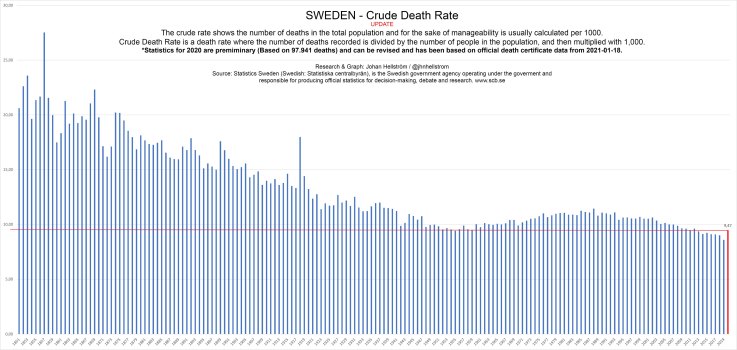
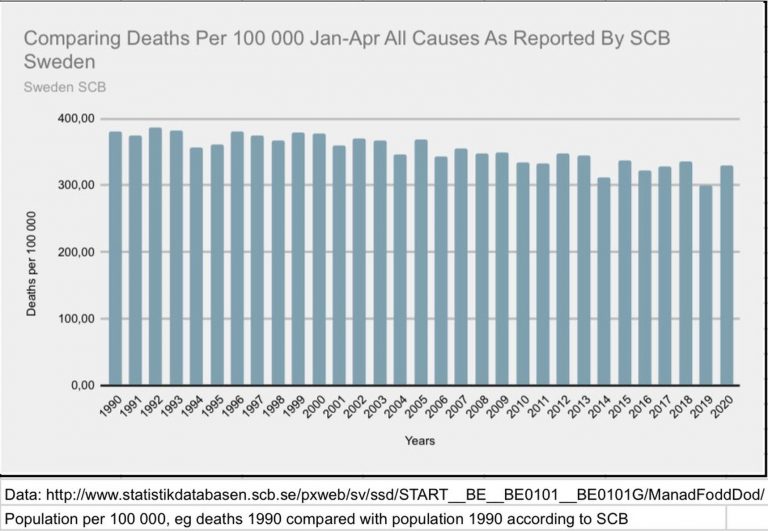
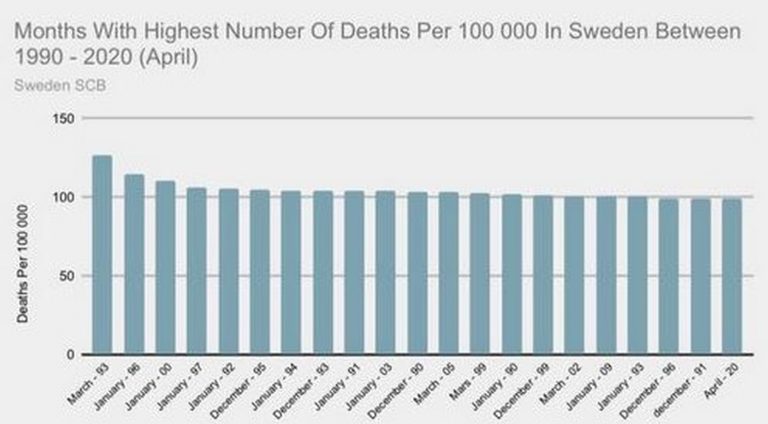
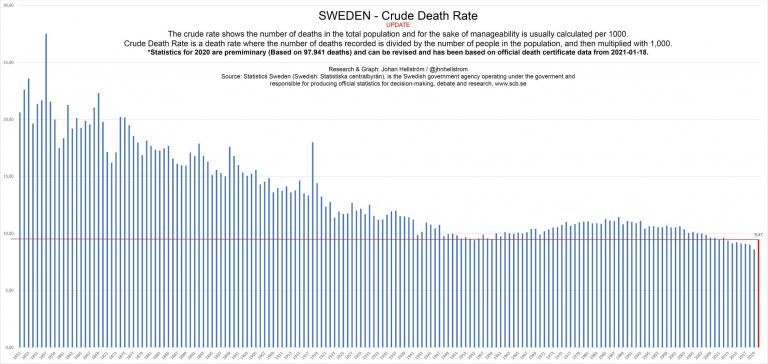
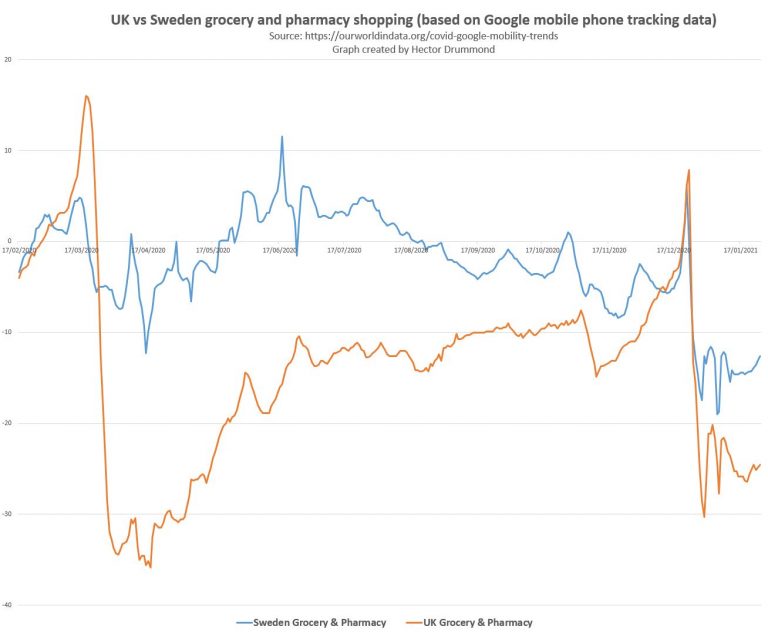
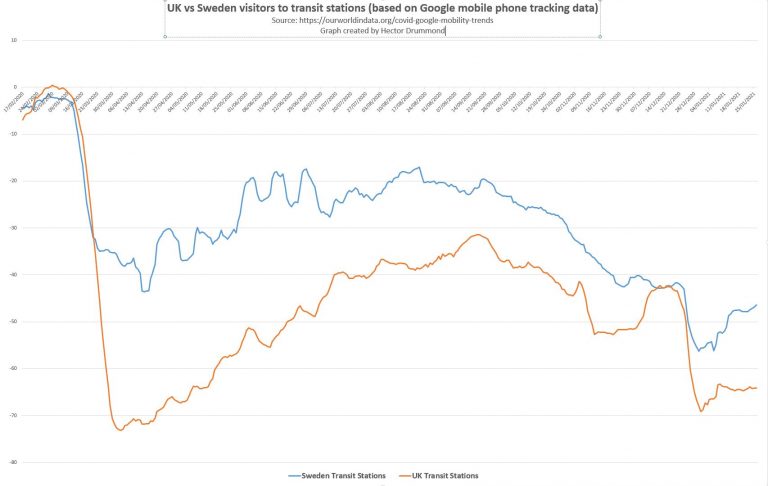
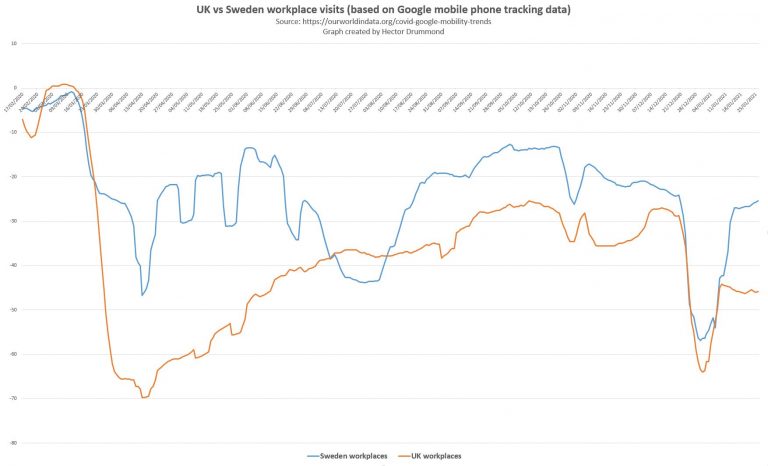
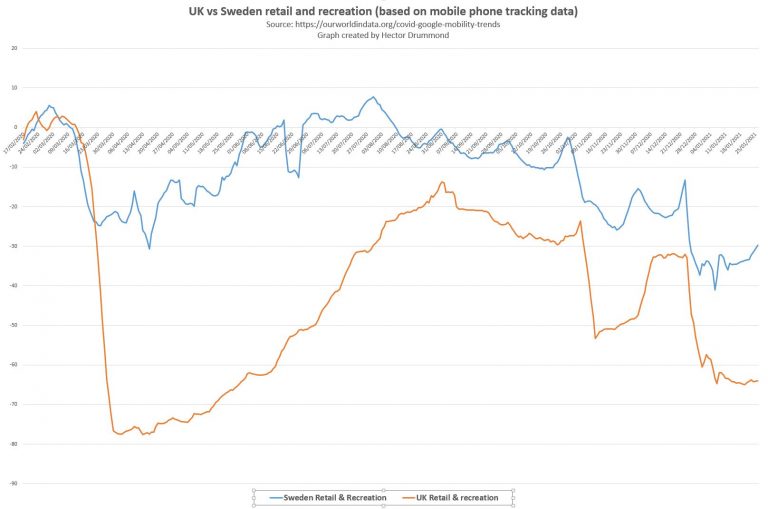
19 thoughts on “Sweden’s figures DO show that lockdowns are a crime”
We can observe similar stats in Europe including the UK. Mainsteam media just compare to the last 5 years (4 of which were unusually low). They also focus on absolute number not per 100,000 as you have correctly done. good work
I took my girls to Stockholm in October -partly for their education- and it was completely normal. What struck me was that nobody was really talking about Covid. I thought I’d pick up their word for ‘Covid’ (maybe from public health messaging or something), but it just wasn’t mentioned. It didn’t seem to hold the power it does here.
So enlightening. Thank you for all the hard work
Good analysis. I wanted to see what was happening and spent 5 nights in Stockholm just before Sweden was taken off the U.K. travel corridors. It was mostly normal and good for the soul! There was a limit on bars and restaurants to a seated capacity of 50 people and everywhere was busy and buzzing.
I suspect you could refine the graph and adjust for age. That would probably remove the downward slope in recent years which I imagine is caused by immigration of young people, not fewer old people dying. What your graph clearly shows is the long term trend of increasing longevity (fewer deaths) and its reversal some years ago with a subsequent increase in deaths. If deaths are on an upward trend, averages are not usable for calculating “excess deaths”.
What shall we do with the Lockdown bullies?
What shall we do with the Lockdown bullies?
What shall we do with the Lockdown bullies?
Early in the morning.
Arrest and charge the bullies,
Try and convict the bullies,
Jail, jail, jail the bullies,
Early in the evening.
‘Nobody in their right mind thinks we should shut the world down indefinitely for a bad flu’
I agree, but I fear something like it will become the norm, perhaps not total shutdown but restrictions and rules each winter.
Excellent Analysis Hector, thanks for this.
Regards,
Fantastic Hector! Sorry I’ve not been to the site for a while. We’re all missing you.
Good work Hector. While the UK numbers are massively abused I would suggest that the UK has had a marginally worse 11 months than Sweden, despite the lockdown. But thankfully I think we will also now see a precipitous drop in UK reported deaths as it becomes politically disastrous to classify the normal deaths of old folk who have been vaccinated as Covid. (Unless of course it’s a mutant conspiracy). That will mean that people suddenly start dying of other stuff. Sudden variations are great for statisticians as you demonstrate above. The UK lie will surely then be exposed?
Very interesting analysis – why the BBC does not check this is a mystery.
A thought about the mobility charts.
They show relative changes within each country (UK and Sweden) compared to a base period. For example, the grocery and pharmacy chart shows the UK fell by ~35% and Sweden by ~12% by the middle of April. But what they don’t seem to show is a comparison of the bases so if, for example, Sweden’s G&P activity is normally ~25% lower than the UK and it fell a further 10%, then both would be down to about the same level. The result might be a similar level of societal disconnection but reached in different ways so UK lockdown might have been needed to reach a Swedish rate of infection.
I’m not claiming this happened, just that I think the data needs further cross-country comparison before reliable conclusions can be drawn.
Florida says thanks to Sweden for being the model to follow.
As a person who fights everyday here in Spain, with really tiny hope left, to make people understand the kind of world we are heading to, I thank you deeply.
The magnitude of the crazyness here is so big that it certainly looks like the whole country is a cinema set for a horror movie.
I´ll share it. Thanks again.
Comments are closed.